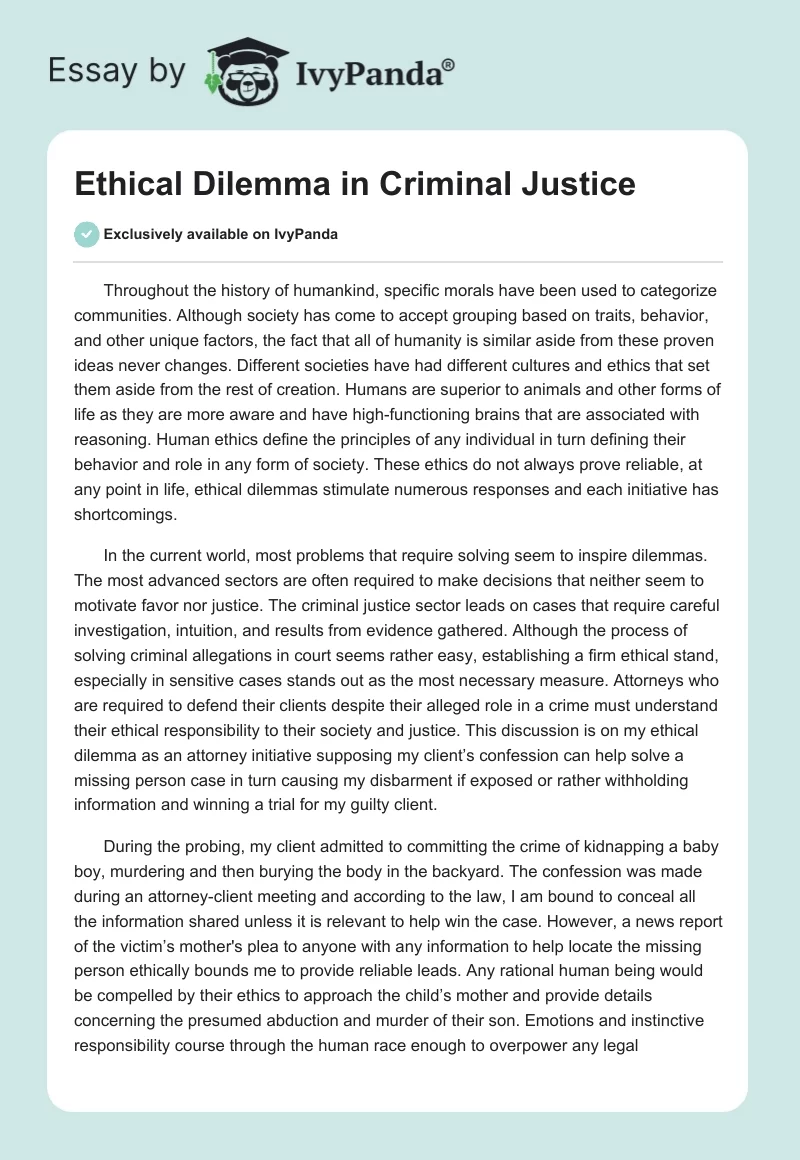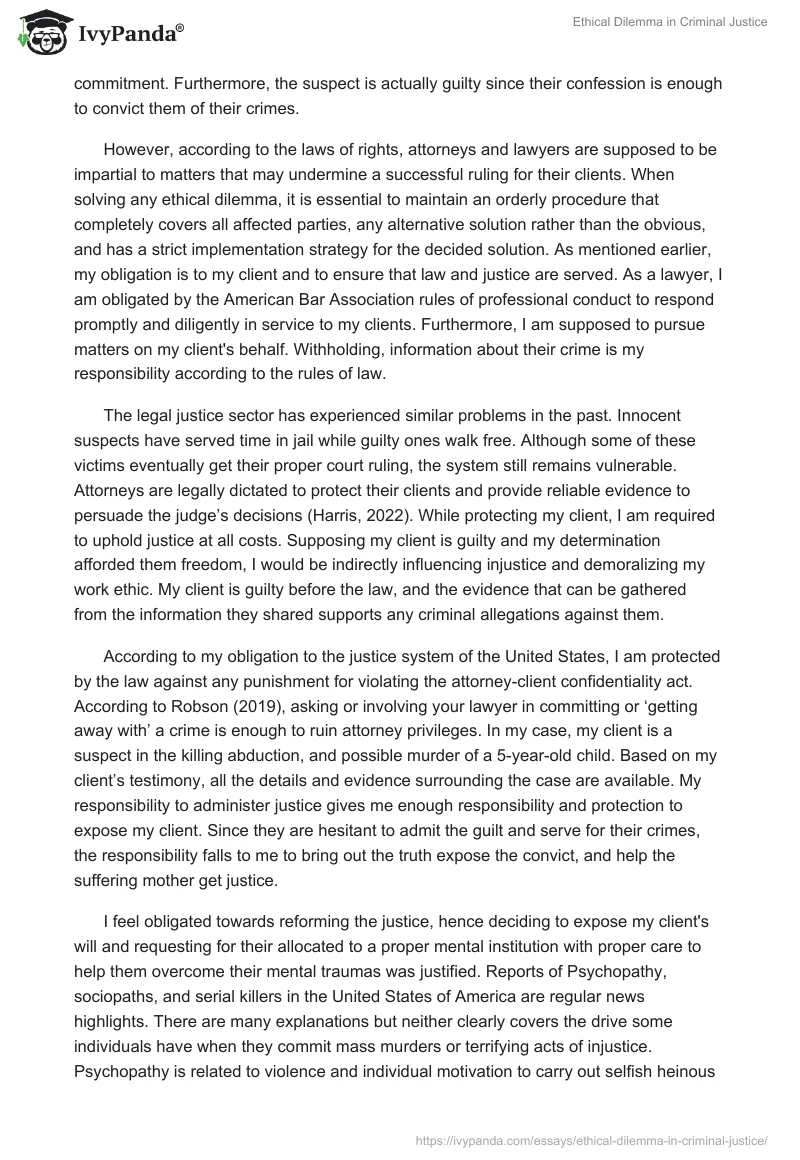Throughout the history of humankind, specific morals have been used to categorize communities. Although society has come to accept grouping based on traits, behavior, and other unique factors, the fact that all of humanity is similar aside from these proven ideas never changes. Different societies have had different cultures and ethics that set them aside from the rest of creation. Humans are superior to animals and other forms of life as they are more aware and have high-functioning brains that are associated with reasoning. Human ethics define the principles of any individual in turn defining their behavior and role in any form of society. These ethics do not always prove reliable, at any point in life, ethical dilemmas stimulate numerous responses and each initiative has shortcomings.
In the current world, most problems that require solving seem to inspire dilemmas. The most advanced sectors are often required to make decisions that neither seem to motivate favor nor justice. The criminal justice sector leads on cases that require careful investigation, intuition, and results from evidence gathered. Although the process of solving criminal allegations in court seems rather easy, establishing a firm ethical stand, especially in sensitive cases stands out as the most necessary measure. Attorneys who are required to defend their clients despite their alleged role in a crime must understand their ethical responsibility to their society and justice. This discussion is on my ethical dilemma as an attorney initiative supposing my client’s confession can help solve a missing person case in turn causing my disbarment if exposed or rather withholding information and winning a trial for my guilty client.
During the probing, my client admitted to committing the crime of kidnapping a baby boy, murdering and then burying the body in the backyard. The confession was made during an attorney-client meeting and according to the law, I am bound to conceal all the information shared unless it is relevant to help win the case. However, a news report of the victim’s mother’s plea to anyone with any information to help locate the missing person ethically bounds me to provide reliable leads. Any rational human being would be compelled by their ethics to approach the child’s mother and provide details concerning the presumed abduction and murder of their son. Emotions and instinctive responsibility course through the human race enough to overpower any legal commitment. Furthermore, the suspect is actually guilty since their confession is enough to convict them of their crimes.
However, according to the laws of rights, attorneys and lawyers are supposed to be impartial to matters that may undermine a successful ruling for their clients. When solving any ethical dilemma, it is essential to maintain an orderly procedure that completely covers all affected parties, any alternative solution rather than the obvious, and has a strict implementation strategy for the decided solution. As mentioned earlier, my obligation is to my client and to ensure that law and justice are served. As a lawyer, I am obligated by the American Bar Association rules of professional conduct to respond promptly and diligently in service to my clients. Furthermore, I am supposed to pursue matters on my client’s behalf. Withholding, information about their crime is my responsibility according to the rules of law.
The legal justice sector has experienced similar problems in the past. Innocent suspects have served time in jail while guilty ones walk free. Although some of these victims eventually get their proper court ruling, the system still remains vulnerable. Attorneys are legally dictated to protect their clients and provide reliable evidence to persuade the judge’s decisions (Harris, 2022). While protecting my client, I am required to uphold justice at all costs. Supposing my client is guilty and my determination afforded them freedom, I would be indirectly influencing injustice and demoralizing my work ethic. My client is guilty before the law, and the evidence that can be gathered from the information they shared supports any criminal allegations against them.
According to my obligation to the justice system of the United States, I am protected by the law against any punishment for violating the attorney-client confidentiality act. According to Robson (2019), asking or involving your lawyer in committing or ‘getting away with’ a crime is enough to ruin attorney privileges. In my case, my client is a suspect in the killing abduction, and possible murder of a 5-year-old child. Based on my client’s testimony, all the details and evidence surrounding the case are available. My responsibility to administer justice gives me enough responsibility and protection to expose my client. Since they are hesitant to admit the guilt and serve for their crimes, the responsibility falls to me to bring out the truth expose the convict, and help the suffering mother get justice.
I feel obligated towards reforming the justice, hence deciding to expose my client’s will and requesting for their allocated to a proper mental institution with proper care to help them overcome their mental traumas was justified. Reports of Psychopathy, sociopaths, and serial killers in the United States of America are regular news highlights. There are many explanations but neither clearly covers the drive some individuals have when they commit mass murders or terrifying acts of injustice. Psychopathy is related to violence and individual motivation to carry out selfish heinous acts on a wide scale. Most reports of psychopaths involve child victims. My client’s actions toward the innocent child are not very different from the initial habits of a developing serial killer. According to Marathe (2022), the legal system should work towards making further amendments to deal with mentally corrupted culprits. Although institutions are available to detain these individuals, society should help identify them to reduce danger.
I am aware that not uncovering the crime may cause more deaths and more individuals may get the motivation to commit murder assuming the justice system is lenient to criminals. As a moral person, my responsibility toward the safety of my community should come above all else. A safe community is very productive, genuinely motivating, and ever-growing. The young generation is responsible for carrying forward the American legacy (Smithyg, 2022). Allowing people who have no mercy and love for the young generation to roam our towns is killing our nation’s hopes. The legal system indicates that lawyers have better influence towards helping achieve the greater good in society. When taking on a case from a client, a proper understanding of the consequences and the public figure displayed by any initiative must always work in favor of a better society.
Although the confession is enough to convict my client, there may still be more evidence connected to the murder. Therefore revoking my client’s privilege and requesting the judge presiding over the case to sanction a new investigation would help discover more evidence to verify my client’s accusations. Considering the information provided gives me more privilege and domain towards exposing a hidden crime, I can reinforce my advantage to uncovering more crimes assuming their crimes exceeded the recorded category. The criminal justice system has not managed to solve most murder cases since the culprits are effective at erasing information that may help in their capture (Pollock, 2021). As a lawyer, it is my responsibility to uncover all details that incriminate my client while avoiding confrontations. It is not unheard of that the real culprits use others to shield them from the law while committing some crimes. Since setting up others as scapegoats have become very common, especially with help from technology, it is essential to discover the real murderer.
Generally, based on the accused situation and his unwilling stance to confess the killing of the boy, it is immoral to keep the secret as an attorney. All lives matter and the deceased deserve justice as well which the court should be able to grant upon receiving adequate evidence. However, telling the judges about the involvement of my client in the murder of the child will further complicate the situation of the offender who is fighting for his freedom. Therefore, failure to inform the court about the murder is unethical and reveling the issue to jury is unprofessional as it will complicate the accused. In this case, I will not disclose the details to the judges despite being immoral conduct.
References
Harris, B. (2022). When does attorney-client privilege not apply? Harris & Harris injury lawyers. Web.
Marathe, N. (2022). Should the justice system be amended for psychopaths? kinesismagazine.com. Web.
Pollock, J. M. (2021). Ethical dilemmas and decisions in criminal justice. Cengage Learning.
Robson, E. D. W. A. R. D. (2019). Four ways to ruin the attorney-client privilege and get yourself in trouble. Robson and Robson. Web.
Smithyg, J. (2022). What is the role of a lawyer in society? Legal service India – law, lawyers and legal resources. Web.


